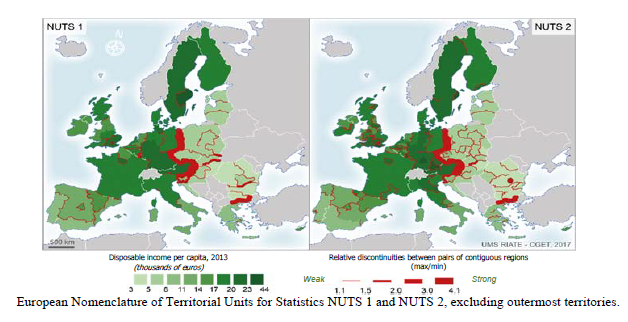Economie et Statistique / Economics and Statistics n° 497-498 Disparities and territorial discontinuities in France with its new regions: A multiscalar and multidimensional interpretation
Article on one page
Key question
The territorial reform of 2015 substituted, from 1 January 2016, 22 metropolitan regions with 13 new regions. One of the issues of the reform is to provide the new regions with a critical size enabling them to compete with comparable communities in Europe. What are the effects of the new regional map on the relative position of French regions compared to their European counterparts? At the national level, does the merger of territories contribute to the mitigation or, on the contrary, the strengthening of disparities and territorial discontinuities?
Methodology
The sociodemographic profile of the territories is characterized by 5 indicators (population density, youth index, standard of living, employment rate and change in employment since 2008). Several geographical levels are mobilised: the European Nomenclature of Territorial Units for Statistics, NUTS, of levels 1 (103 units, by integrating the new French regions) and 2 (276 units, including the former French regions) and the 321 French Employment Zones. The disparities and territorial discontinuities are highlighted using statistical and spatial data analysis methods.
Main results
The demographic weight of the new French regions, excluding overseas regions, is rather modest (on average, 4.9 million inhabitants) in comparison with territories of the same level (NUTS 1) of other major European States. However, by remaining at the first sub-national territorial management level (NUTS 1 or NUTS 2 depending on the States), their population is close to that of the German Länder, on average 5.0 million inhabitants (NUTS 1), way ahead of Spanish communities and Italian regions (NUTS 2). The inter-regional sociodemographic contrasts appear relatively low in France, in comparison with other European States. For the income indicator, the Central and Eastern Europe countries are showing the highest discontinuity.
In France, some of the merged regions appear relatively homogeneous (Nouvelle-Aquitaine, Bourgogne-Franche-Comté and Normandie) unlike others where contrasts are much more pronounced (Hauts-de-France, Occitanie, Auvergne-Rhône-Alpes and Grand Est).
At the level of Employment Zones, the main territorial breaks can be seen within the same regions (cities versus rural or suburban territories, cross-border or coastal territories versus interior territories…).

Main message
Although the main objective of the French territorial reform of 2015 was not to respond to the European ambition for territorial cohesion, the deployment of public policies on these new territories with enhanced skills will probably have multiple impacts, including on territorial disparities, which will need to be evaluated over the next few years.
Article on one page (pdf, 62 Ko )



